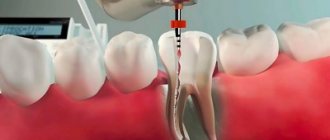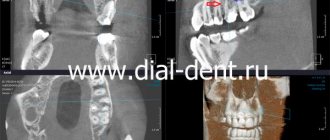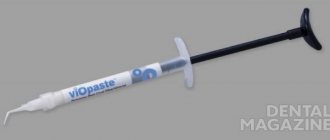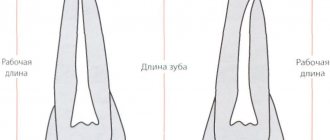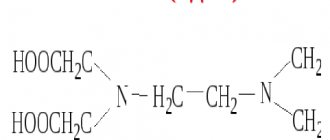Canal unsealing is a dental procedure that is aimed at removing a previously installed filling. Another name for it is “disobturation”. The process requires expansion of the canals in the direction from the crown to the apex of the root for the purpose of high-quality cleaning of dental cavities. The procedure is resorted to after endodontic treatment carried out with violations of technology. It must be carried out on time, since infectious agents that have penetrated the dental tissues will provoke the development of inflammatory processes, which, in turn, can cause the loss of the entire tooth.
The therapeutic department of dentistry CELT invites you to undergo root canal retreatment in Moscow. Our clinic is multidisciplinary and has been offering paid medical services for more than two decades. Our dental therapists have a modern diagnostic and treatment base in their arsenal, thanks to which they are able to accurately and promptly make diagnoses and carry out treatment in accordance with international standards. You can find out the approximate price for unsealing canals by going to the “Services and Prices” tab. We regularly update the price list, but in order to avoid misunderstandings, we recommend that you check the exact numbers with our operators or at a doctor’s appointment.
Consultation with a dentist-therapist - 1,000 rubles.
Unsealing a previously obstructed canal (1 canal) - RUB 3,000.
Unsealing the canal under the stump tab - 1,700 rubles.
At CELT you can get advice from a dental specialist.
- The cost of a consultation with a dentist-therapist is 1,000
Make an appointment
Indications and contraindications for root canal filling
Indications
- Painful symptoms, inflammatory processes and swelling of the gum tissue in a patient who some time ago underwent endodontic treatment;
- Insufficient quality of the filling is its depressurization or poor fit at the edges, which makes it difficult to remove food debris and provokes the development of a carious process;
- Inflammatory or infectious processes of the dental canals under the filling;
- The need for retreatment of root canals for pulpitis, periodontitis, cystic formation, granuloma;
- The need to install an intracanal pin;
- Violations of the previously performed root canal obturation technology.
Contraindications
- Serious damage to the periodontal tissues surrounding the unit, which is not an obstacle to saving the tooth;
- The unit is unsuitable for restoration;
- Impossibility of intervention on its closed part;
- Neoplasm of malignant etiology in the area of the affected unit;
- A purulent-necrotic process that affects bone tissue;
- General serious condition of the patient.
Why undergo a dental canal refilling procedure?
There are several reasons why you need to re-treat a dental canal:
- persistence or resumption of pain after filling;
- X-ray shows the presence of inflammation;
- incomplete closure of dental canals.
In addition, complications may result from errors or inaccuracies that arose during treatment. For example, when preparing the canal for treatment, an infection was introduced, access to the base of the canal is impossible, or there are pathological holes in the walls of the tooth or its bottom. In addition, no one is immune from the mistakes of the doctor performing root canal treatment.
When treating a dental canal before filling, the following problems most often occur:
- Dentim gets into the sawmill,
- the middle part of the canal is greatly expanded,
- tool failure,
- the integrity of the root walls is compromised.
When filling a canal, the main problems arise if it is not completely filled, the filling material extends beyond the hole, or there is a longitudinal fracture at the root of the tooth. Medical errors are also possible at this stage - the doctor may incorrectly estimate the length of the canal or not completely clean it. This may contribute to the development of inflammation.
Features and stages of unfilling root canals using medication
Chemical deobturation is carried out using one of two methods:
- Moderate complexity - performed in one visit and indicated if you need to remove hardening pastes. The latter dissolve well with organic solvents and are easily removed using endodontic instruments. In this case, canal retreatment under a microscope is carried out in one visit to the dentist;
- High complexity - indicated if the canals were filled with cement or resorcinol-formalin paste, rarely required when treating patients with old fillings. A dissolving gel is instilled into the canal, and after the filling has softened, a special tool is inserted into it, which allows it to be removed by turning it clockwise and counterclockwise. The dentist must work very carefully so as not to damage the integrity of the canal walls or break the instrument. This type of filling requires two visits to the doctor.
Stages of chemical unsealing:
- Removing a surface filling with a dental bur;
- Applying solvent to old material;
- Careful removal of the filling material after it has softened;
- Removal of tissue affected by caries, treatment of other diseases;
- Re-filling of canals.
How does the process of refilling dental canals take place?
The current level of development of medicine in the field of dentistry is quite high. But dentists make mistakes, which is why filling dental canals again is quite common. At this point in time, doctors use several methods for performing this procedure.
Mechanical methods involve the use of a special instrument - an endodontic motor and an apex locator. In this case, antiseptic agents are added to the filling material. To prevent the development of inflammation, the doctor must very carefully and completely fill the dental canal with filling material.
Medicinal methods involve the use of products with organic solvents. They are able to soften and destroy the filling in a few minutes.
The cement filling can be removed from the canal using ultrasound and an endo-nozzle. This canal cleaning is usually carried out in one procedure.
Reviews of doctors providing the service - root canal unfilling
I would like to express my gratitude to the dentist Elena Nikolaevna Kiseleva and her assistant Svetlana - they are real specialists and at the same time sensitive, not burnt out by years of practice.
Thanks to them, I have been coming back here for many years. Thanks to the management for such doctors! Read full review Svetlana Nikolaevna
13.08.2021
Words cannot express my gratitude to Elena Nikolaevna Kiseleva. This is the best doctor in the world. I got an appointment after many years of being ignored by the dentist’s office and with a bitter experience of treatment in another paid clinic, the mistakes of which had to be corrected in the first visits. Thank you for this... Read full review
Roman Stanislavovich Sh
25.07.2020
Closing options
Today, there are many ways to fill the root canals of a tooth. One of the most popular materials is the use of hardening paste.
This method is relatively cheap and can be used even in cases of complex structure of dental canals. However, when filling with paste, reliable insulation is not guaranteed.
A more reliable method of filling is the combined use of hardening paste and a pin.
During this manipulation, the channel is simultaneously filled with paste and a pin, which compacts the substance and allows it to be more reliably distributed in the cavity.
Another method of obturation is lateral (or lateral) condensation. When using it, the canal is filled with gutta-percha pins and at the same time a hardening composition. This method fills and seals the canal very firmly.
The Thermofil system differs from all previous methods by the ability to seal not only the main cavity, but also the side tubules.
During the manipulation, an endobturbation system is introduced into the canal, with the help of which a pin and hardening paste under pressure fill the tooth cavities.
The method makes it possible to isolate the canal very firmly, however, if it is necessary to carry out repeated treatment in the future, serious difficulties may arise when removing it.
Liquid gutta-percha can also seal the lateral tubules. To perform the manipulation, gutta-percha is preheated in a special device, and then injected into the canal cavity through a cannula.
Why is the procedure so effective?
With the right approach, the procedure allows you to save the tooth due to:
- removal of tissue affected by caries;
- no need for anesthesia;
- eliminating the symptoms of diseases that developed under the filling
The use of a microscope in the process significantly improves its quality, since it allows you to correctly assess the features of the anatomical structure and the condition of the root canals. It is worth noting that the cost of canal retreatment with their use is higher, however, the effectiveness of the procedure increases significantly.
Indications
The procedure is not performed in all cases. For this manipulation there is a list of indications, in the absence of which unsealing is not a justified measure.
The list of indications is as follows:
- The patient experiences pain in a filled tooth some time after the filling is installed;
- Violation of the tightness of the seal;
- Signs of infection - swelling, swelling of the gums, redness, etc.;
- Detection of foci of pathological activity on an x-ray after treatment;
- Incorrect treatment of the pathological focus in the apical part of the tooth root, prior to filling;
- Incomplete filling of the canal with filling material;
- The patient has additional root canals that were not filled during the initial filling.
In other words, unfortunately, most often the reasons for the need to eliminate the results of a previous dental intervention are the incompetence of a professional, the use of low-quality or outdated equipment during the procedures performed.
The main characteristics of the Spectrum filling and the technique for its installation.
Come here if you are interested in the features of the treatment of acute pulpitis.
At this address https://www.vash-dentist.ru/lechenie/zubyi/plombyi/restavratsii-tsementnyih.html we will talk about the service life of a cement filling and the factors affecting its durability.
Reviews
If you or your loved ones have ever faced the need to unfill a tooth's root canal, share your experience with users of our resource.
This can help them choose a specialist and relieve them of unnecessary anxiety during treatment.
If you find an error, please select a piece of text and press Ctrl+Enter.
Tags: treatment, fillings, unfilling of root canals
Did you like the article? stay tuned
Previous article
Pulp extirpation is an effective way to save a tooth.
Next article
Gutta-percha points – high-quality root filling
Possible complications
Unfortunately, not every filling can be removed for subsequent treatment. Sometimes it becomes physically impossible to drill out pins from the filling material.
In addition, there are cases of root canal obstruction associated with the peculiarities of its structure. In such cases, the endodontic cavity has to be prepared.
In addition, during manipulations, errors may be made related to disinfection and mechanical treatment of the canal cavity. Depending on the consequences (infection, tooth decay, etc.), complications can be eliminated by various dental methods.
Root canal irrigation protocols
One of the reasons for the failure of endodontic treatment is the problem of high-quality root canal irrigation.
Irrigation has two major goals:
- Cleansing the root canal system due to the chemical dissolution of organic and inorganic residues, as well as their mechanical washing out with a stream of liquid;
- Disinfection of the root canal system, high-quality preparation and formation of the root canal helps to create the necessary reservoir for the irrigation solution and opportunities for its activation.
The root canal system has a very complex morphology, which is often characterized by the presence of lateral canals and anastomoses, and a branched structure in the apical part.
In the event of pulp death, dehydration of the dentinal tubules occurs, in the lumen of which only tissue decay of the processes of odontoblasts remains; the migration of microorganisms and toxins easily occurs along the lumen of the tubules; the dentinal tubules may contain bacteria that penetrate into them both from the oral cavity and from the root canal system. Since these bacteria can lead to failure of endodontic treatment, they must be eliminated.
During the preparation of hard tooth tissues with hand or machine instruments, a microscopic layer of sawdust is formed on the surface of the dentin. The smear layer formed during endodontic treatment is characterized by a high content of organic components in the form of pulp fragments, odontoblasts, and weakly mineralized predentin. At the same time, there are also inorganic components, the source of which is dentin. In this regard, to remove the smear layer from the walls of the root canal, it is necessary to use solutions that are effective against both organic and mineral components.
The smear layer of the root canal may contain microorganisms and serve as a breeding ground for them, as well as disrupt the adhesion of filling materials to the walls of the root canals. In connection with the above, the smear layer of the root canal must be completely removed. Peritubular dentin, highly sensitive to EDTA or acid solutions, is completely dissolved.
Irrigation solutions
- Sodium hypochlorite
Sodium hypochlorite (NaOCl) has both oxidizing and hydrolyzing properties: it has bactericidal and proteolytic effects. The solution was proposed for use as a wound irrigant as early as 1915, and began to be used as an irrigant solution for endodontics in the United States around 1920.
Many studies have demonstrated its antiseptic and solvent properties. In particular, NaOCl has a rapid bactericidal effect against vegetative forms, spore-forming bacteria, fungi, protozoa and viruses (including HIV, rotavirus, HSV-1 and -2, hepatitis A and B viruses). The exact mechanism of the antimicrobial activity of NaOCl is not entirely clear, but it may be determined by the formation of hypochlorous acid and the release of active chlorine, which leads to the oxidation of sulfhydryl groups of important bacterial enzymes. Sodium hypochlorite has pronounced dissolving properties against pulp residues, even those located in lateral and additional canals.
The dissolving effect is determined by the concentration of sodium hypochlorite: the maximum severity of the effect is manifested in a 5% NaOCl solution. To increase the effectiveness of sodium hypochlorite as a solvent for tissue decay, it is recommended:
- use a heated solution with a temperature of about 40°C;
- activate and heat the solution using ultrasonic files;
- use temporary root canal filling with calcium hydroxide to take advantage of the synergistic effect of these two substances;
— EDTA components
EDTA is used in endodontics in the form of a liquid or gel as a chelating agent that extracts calcium ions from hydroxylapatite, thereby dissolving the mineral fraction of the smear layer of the root canal O'Connell in a recent study indicates that the isolated use of EDTA without sodium hypochlorite does not In one case, it did not ensure complete removal of the smear layer of the root canal. This explains the advisability of alternating EDTA-containing agents and hypochlorite during endodontic treatment; their combined effect provides an excellent degree of cleaning of the dentinal walls in the apical third of the root canal, provided that both substances are brought to the apex and activated using ultrasound or manual files
— Acidic components
The acids used in endodontics for washing canals are phosphoric and citric in concentrations from 6% to 30%. Acid solutions are highly effective in removing the mineral component of the smear layer of the root canal and in the treatment of obliterated canals. However, since their effectiveness as antiseptics and organic solvents is limited, combined use with sodium hypochlorite is recommended. One recent study examined the effectiveness of two different combinations of irrigation solutions (NaOCl + EDTA and NaOCl + phosphoric and citric acid) for smear layer removal. The results obtained indicate that both concentrations were effective, although the use of EDTA was characterized by a more gentle effect on peritubular and intertubular dentin.
After using acids, it is recommended to rinse the canal with distilled water, since there is a tendency for crystallization and precipitate to form on the canal walls.
— Chlorhexidine
The dissolving effectiveness of chlorhexidine relative to organic and mineralized tissues is not expressed. Chlorhexidine can be used for short-term temporary filling of root canals.
You cannot combine chlorhexidine with hypochlorite; a carcinogenic precipitate called parachloraniline is formed!
You can do this: Hypochlorite - distilled water - chlorhexidine.
Irrigation sequence during root canal preparation
- Remove the roof of the pulp chamber and rinse with sodium hypochlorite to remove residual pulp and identify root canal orifices;
- Begin instrumental treatment of the canal lumen, alternating it only with sodium hypochlorite;
- When starting to excise dentin, fill the canal lumen with EDETAL material.
- Continue instrumentation
- Rinse the channel with sodium hypochlorite until foaming stops;
- Complete the instrumentation, ensuring that the canal always remains filled with EDETAL, flushing the canal with sodium hypochlorite after every 3-4 instruments;
In the vast majority of cases, some of the canals remain untreated and unfilled, and the results of endodontic treatment, despite this, are satisfactory. This is the merit of a good immune system. But in many cases, insufficient cleaning of the root canals leads to unsuccessful results of endodontic treatment.
An attempt should be made to dissolve the remaining pulp tissue using chemical methods, and then, if possible, completely remove it from the root canals. This is the purpose of continuous root canal irrigation.
What concentration of hypochlorite should I choose? There are as many opinions as there are authors.
Very interesting research by Dr. David Sonntag: "Sodium hypochlorite at a concentration of 1 to 5.25% is by far the most suitable solution for chemical cleaning of the root canal system. NaOCl has the unique ability to dissolve necrotic tissue debris as well as organic components of the smear layer. However the activity of chlorine in the root canal can be exhausted within two minutes at the first stage of tissue dissolution. Therefore, in the process of developing the canals, irrigation should be carried out constantly with new portions of the solution. The effectiveness of the antimicrobial and tissue-dissolving effects of an aqueous solution of sodium hypochlorite increases with increasing concentration of the solution. However, the reduction in the number of bacteria in the canal after root canal irrigation with a 5% solution is no higher than after using a 0.5% solution for this purpose (Bystrom and Sundqvist, 1985; Cvec et al., 1976). When using a solution of 1% concentration, the necessary tissue dissolving effect is achieved. Since the concentration of a solution may decrease with changes in temperature or exposure to light, it is possible that, practically speaking, it would be better to use the solution in higher concentrations. To increase the effectiveness of NaOCl, it is advisable to heat the solution, for example, to 55 °C. When the temperature increases by 5° in the range from 5 to 60 °C, the bactericidal effect of NaOCl more than doubles. A 1% NaOCl solution at a temperature of 45 °C is as effective at dissolving organic tissue residues as a 5.25% NaOCl solution at a temperature of 20 °C. At the same time, the toxicity of a one percent solution and, accordingly, the risk of using such a solution in a heated state is much lower . A chlorhexidine solution (obviously, regardless of concentration) does not have the ability to dissolve tissue.
For complicated forms of pulpitis and periodontitis, a protocol with chlorhexidine is proposed:
The irrigation protocol is as follows: sodium hypochlorite 5.25% - distilled water - EDTA 17% - distilled water - chlorhexidine
The intermediate irrigant should be distilled water to prevent as much as possible the chemical interaction between the remainder of one solution and another solution introduced into the canal on different bases (alkaline and acidic). Chlorhexidine does not need to be washed out of the canal; it is enough to just dry the canal, since it does not affect the polymerization and adhesive properties of obturation materials. After this, it is necessary to evacuate moisture from the canal using paper points, while it is important not to overdry the root canal, so as not to make the dentin more fragile.
A little more about EDTA. In gel form, EDTA-based preparations are an excellent lubricant, ensuring better contact of the cutting tool with the cut surface, which also increases the efficiency of machining the tooth canal. Many authors point out another interesting property of EDTA gels. They optimize the electrical conductivity of the root canal system during apex location. It is believed that apeslocation carried out in the presence of a large amount of lubricant gives the most accurate results.
Omega Dent produces two EDTA-based drugs:
- "Edetal liquid"
- "Edetal gel"
The gel has a foaming effect, which promotes better evacuation of dentinal filings that arise during the mechanical treatment of the canal.
Sodium hypochlorite solutions also facilitate mechanical treatment of the canal along with EDTA preparations. There are techniques in which only sodium hypochlorite is used to soften the dentinal canal wall, which, however, can make the apex locator readings less accurate due to the high electrical conductivity of the solution. Preparations based on sodium hypochlorite are the most active antiseptics. This property is due to a high degree of electrolytic dissociation with the release of atomic oxygen and chlorine. The release of gases promotes foaming, which, as already mentioned, facilitates the evacuation of the canal contents during preparation.
"Omega Dent" produces: preparations "Hypochloran-3" and "Hypochloran-5", containing 3.25% and 5% sodium hypochlorite.
In modern endodontic practice, various concentrations of sodium hypochlorite solutions are used. There is a well-established opinion that the antiseptic activity of this antiseptic depends not so much on its concentration as on exposure, that is, the time of exposure of the solution to the contents of the canal. With longer rinsing, the canal is better cleaned mechanically and a larger number of microorganisms die and leave the canal. The antiseptic properties of solutions are also significantly enhanced when heated. However, only a 5% concentration of sodium hypochlorite solution has proteolytic properties, which is important in the treatment of periodontitis teeth, the canals of which are filled with pulp decay, microorganisms and their toxins. But it is important to consider that the entry of sodium hypochlorite solutions into the oral cavity causes such unpleasant reactions in patients that it may make it impossible to continue treatment. Therefore, the use of a rubber dam is mandatory when performing endotherapy.
To obtain a 0.5% solution, hypochlorite 3% concentration should be diluted with distilled water in a ratio of 1:5 and heated to 37 degrees.
As a result of the purulent-inflammatory process in the pulp and periodontal tissues, the infection penetrates through the dentinal tubules and into the thickness of the root dentin. Therefore, the traditional method of antiseptic treatment of the root canal does not guarantee against its reinfection. Based on this, along with the traditional method of canal treatment, it is necessary to carry out temporary root obturation with sterile calcium hydroxide for a prolonged antiseptic effect on the root canals.
